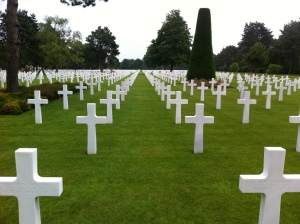
Photo credit: V. Laino
For me, there’s no greater experiential learning than walking back through time via travel. The chariot tracks in the streets of Pompeii made life in the first century that much more real to me. Seeing row after row of crosses in the Normandy American Cemetery in France made the sacrifices of those soldiers that much more apparent. My birthday happens to fall on the anniversary of D Day, and reading June 6, June 6, June 6 over and over again on so many of those markers reminded me of what a true sacrifice those men had made so that I would someday have a special day while they would never again see one.
My grandparents and their friends used to talk about the war, but in oblique ways. There would be mention of training, moving to bases, spending time in Washington but never any talk of actual battle, or bloodshed, or killing. Visiting a Nazi bunker in Hamburg, Germany, and seeing how closely it was positioned to the river and how it stood as the last line of defense (gunners atop it tried to shoot down planes) before U boats and submarines were reached made the dangers of that era so much more real. A church damaged during the war is emblematic of collateral damage that just couldn’t be avoided. An eternal flame burning at a war memorial in Yaroslavl, Russia reminded me that one-time enemies found common ground to fight a larger evil.

Photo credit: M. Ciavardini
Visits to France, Germany, and Russia in the last year or so have reignited my interest in European history. Although I am a political science major and took plenty of history courses in college, I’d forgotten that Napoleon’s army had made it all the way to Moscow until I saw one of his canons at the Kremlin. I’d never really thought about what civilians fleeing an invading army might do until I viewed the replacements in the amber room at the summer palace of Catherine the Great in Pushkin, 16 miles from St. Petersburg. Russians bent on preserving the works of the place from invading Germans removed the amber panels, and they have never been found.

Through travel, I have come to appreciate how very hard, and often horrible, life was in earlier generations. The oldsters still among us don’t often talk about it. I am so much more appreciative, thanks to my travels, when I am walking their ground.
On My Reading Table:
Barbara Tuchman, The Proud Tower (1962), ISBN 0-553-23456-0 (life before World War I).
Jacques Baynac, The Story of Tatiana (1994) (chronicling the life of a Russian revolutionary and assassin who killed the wrong man in 1906).
Rachel Polonsky, Molotov’s Magic Lantern: Travels in Russian History (2010), ISBN: 978-0-374-53320-5.
N. Popov, Outline History of the Communist Party of the Soviet Union, Part 1 (1934).
Sergei N. Kournakoff, Russia’s Fighting Forces (1942), ISBN: 1125258020 (a book about World War II written prior to its end).

Relevant Films:
Stalingrad
The Fall of Berlin
Russians Deprived of Russia
National Geographic: Wrath of the Tsar
Russia: Land of the Tsars
Enemy at the Gates
All Quiet on the Western Front
National Geographic: Empress of Ambition
© Lori Tripoli, 2012



3 thoughts on “Standing in the Tracks of Chariots and on the Paths of Heroes”